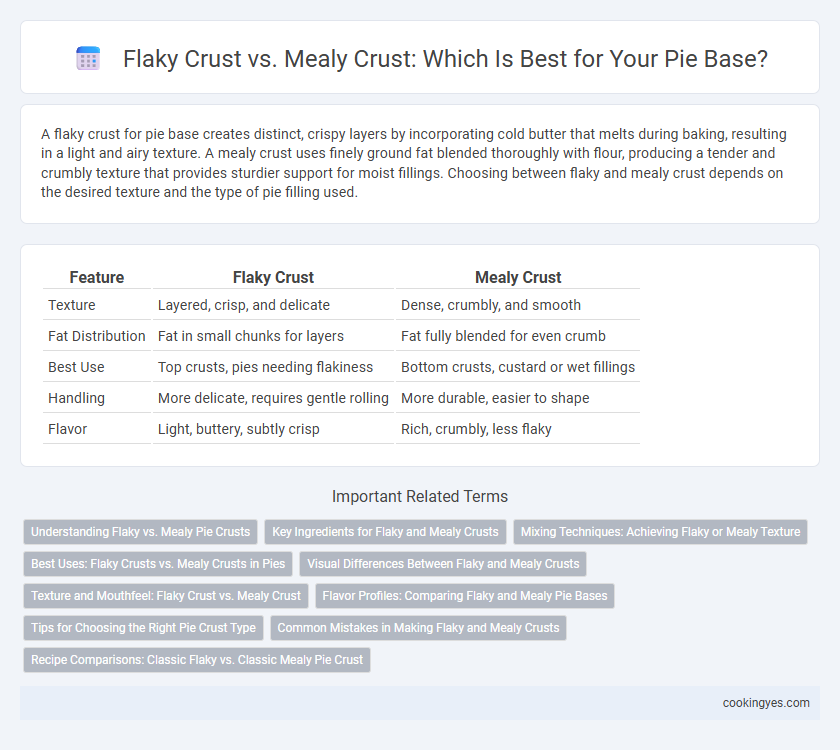A flaky crust for pie base creates distinct, crispy layers by incorporating cold butter that melts during baking, resulting in a light and airy texture. A mealy crust uses finely ground fat blended thoroughly with flour, producing a tender and crumbly texture that provides sturdier support for moist fillings. Choosing between flaky and mealy crust depends on the desired texture and the type of pie filling used.
Table of Comparison
| Feature | Flaky Crust | Mealy Crust |
|---|---|---|
| Texture | Layered, crisp, and delicate | Dense, crumbly, and smooth |
| Fat Distribution | Fat in small chunks for layers | Fat fully blended for even crumb |
| Best Use | Top crusts, pies needing flakiness | Bottom crusts, custard or wet fillings |
| Handling | More delicate, requires gentle rolling | More durable, easier to shape |
| Flavor | Light, buttery, subtly crisp | Rich, crumbly, less flaky |
Understanding Flaky vs. Mealy Pie Crusts
Flaky pie crusts achieve their texture by incorporating larger pieces of cold fat into the dough, which create distinct layers when baked, resulting in a light, crisp bite. Mealy pie crusts feature finely ground fat mixed thoroughly with flour, producing a dense, crumbly texture ideal for holding moist fillings without becoming soggy. Choosing between flaky and mealy crusts depends on the desired texture and the type of filling, with flaky favored for dry fillings and mealy preferred for wet or custard fillings.
Key Ingredients for Flaky and Mealy Crusts
Flaky crusts rely on cold, solid fats such as butter or shortening cut into the flour to create distinct, layered pockets during baking, while keeping the dough cold prevents gluten development for tenderness. Mealy crusts use finer fat incorporation and more liquid, often with additional sugar or egg yolks, resulting in a denser, crumbly texture ideal for custards and fruit pies. Key ingredients like cold butter and minimal water contribute to flakiness, whereas thorough fat distribution and balanced hydration yield a mealy consistency.
Mixing Techniques: Achieving Flaky or Mealy Texture
Flaky pie crusts require minimal mixing with cold butter or fat cut into coarse pieces, creating distinct layers that puff during baking. Mealy crusts involve thorough mixing, with fat fully incorporated into finer crumbs, resulting in a tender, crumbly texture ideal for custard or cream pies. Controlling moisture and mixing time directly impacts whether the crust develops a light, flaky bite or a dense, mealy base.
Best Uses: Flaky Crusts vs. Mealy Crusts in Pies
Flaky crusts, made with cold fat and minimal handling, excel in fruit pies where a light, crisp texture complements juicy fillings. Mealy crusts, created by thoroughly cutting fat into flour, offer a tender, crumbly base ideal for custard or cream pies that require a sturdy, moisture-resistant foundation. Selecting the appropriate crust enhances the pie's overall texture and prevents sogginess by matching crust characteristics to the filling type.
Visual Differences Between Flaky and Mealy Crusts
Flaky crusts exhibit distinct, layered textures with visible, thin sheets that separate easily, creating a light and crispy appearance ideal for fruit pies. Mealy crusts, in contrast, have a more uniform and dense structure with a smooth surface and less obvious layering, providing a tender and crumbly texture suitable for custard or cream pies. The visual contrast lies in the flaky crust's golden, irregular layers versus the mealy crust's matte, solid finish.
Texture and Mouthfeel: Flaky Crust vs. Mealy Crust
Flaky crust boasts a light, layered texture achieved through cold butter or shortening that creates pockets of steam during baking, resulting in a tender, crisp mouthfeel. Mealy crust features a fine, crumbly texture due to thorough mixing of fat into flour, producing a dense, sturdy base that resists sogginess, ideal for moist fillings. The choice between flaky or mealy crust depends on desired pie structure and the optimal balance between crispness and durability.
Flavor Profiles: Comparing Flaky and Mealy Pie Bases
Flaky pie crusts, made with larger fat pieces and minimal mixing, create a layered texture that enhances buttery, crisp flavors, complementing fruit pies and savory fillings. Mealy crusts, characterized by finely ground fat incorporated thoroughly into flour, offer a tender, crumbly texture with a less distinct buttery taste, making them ideal for custard or cream pies. Flavor profiles differ as flaky crusts provide lightness and contrast, while mealy crusts deliver a denser, more uniform base that emphasizes the pie's filling.
Tips for Choosing the Right Pie Crust Type
Flaky crusts, made with cold butter or shortening cut into coarse pieces, create distinct layers that rise and separate during baking, ideal for fruit pies needing a light, airy texture. Mealy crusts, with fat fully incorporated into the flour, yield a tender, crumbly base perfect for custard or cream pies requiring a sturdy, moisture-resistant layer. Choose flaky crust for crispness and texture; select mealy crust for durability and to prevent sogginess when holding wet fillings.
Common Mistakes in Making Flaky and Mealy Crusts
Common mistakes in making flaky crusts include overworking the dough, which leads to toughness instead of the desired light, layered texture. In contrast, mealy crust errors often involve insufficient blending of fat and flour, resulting in a crumbly and dry base rather than a tender, stable one ideal for custard or fruit pies. Temperature control is crucial; warm ingredients cause excessive gluten development in both crust types, compromising flakiness and tenderness.
Recipe Comparisons: Classic Flaky vs. Classic Mealy Pie Crust
Classic flaky pie crust features high butter content with larger fat pieces, creating layers that puff and separate for a light, airy texture ideal for fruit pies. The classic mealy pie crust uses finely ground fat blended thoroughly into flour, resulting in a dense, tender, and crumbly base perfect for custard and cream pies. Recipe comparisons highlight flaky crust's superior flakiness versus mealy crust's resistance to sogginess, making each suited to different pie types and fillings.
Flaky crust vs mealy crust for pie base Infographic

 cookingyes.com
cookingyes.com